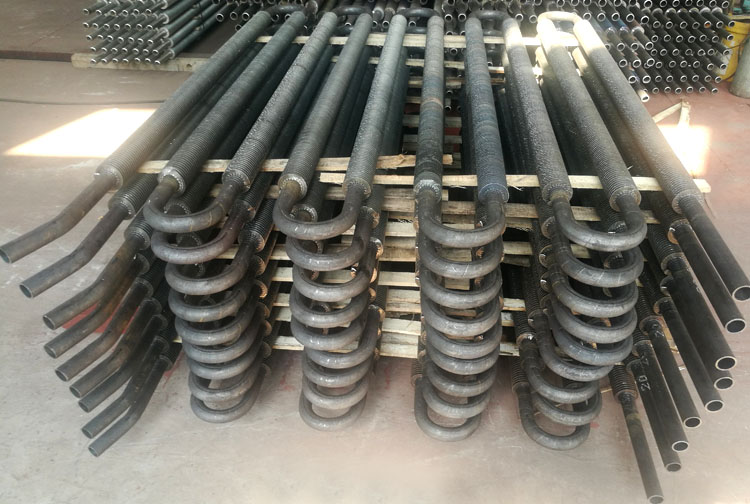What is a Finned Tube Condenser?
Finned tube condensers are advanced heat exchangers engineered to efficiently convert vapor into liquid by transferring latent heat to a coolant medium. Unlike conventional plain tubes, their extended fin surfaces amplify heat transfer efficiency by up to 60%, making them indispensable for energy-intensive applications across HVAC, power generation, and chemical processing industries.
Enhanced Heat Transfer
Fins increase surface area by 3-5x, boosting thermal conductivity 30-50% compared to smooth tubes.
Space Optimization
Compact design reduces equipment footprint by 40% while maintaining equivalent thermal performance.
Energy Efficiency
Optimized heat exchange reduces energy consumption by 15-25% in HVAC and refrigeration systems.
Finned Tube Condensers Technical Specifications
Standard Design Parameters for Industrial Applications
| Parameter | Standard Range | Unit | Impact on Performance |
|---|---|---|---|
| Tube Outer Diameter | 19.05 - 50.8 | mm | Larger diameters improve flow but reduce surface-to-volume ratio |
| Fin Height | 6.35 - 25.4 | mm | Higher fins increase surface area but may reduce structural integrity |
| Fin Pitch | 1.5 - 5.0 | fins/cm | Higher density improves heat transfer but increases pressure drop |
| Cooling Water Flow Rate | 15 - 45 | m³/h | Higher flow increases heat transfer coefficient but requires more pumping power |
| Heat Transfer Coefficient | 3500 - 5500 | W/m²K | Higher values indicate more efficient heat exchange |
| Material Combination | Cu-Al, Cu-Cu, SS-Al | - | Affects corrosion resistance, thermal conductivity, and cost |
Data Source: ASHRAE Handbook & Industrial Thermal Engineering Standards (2023)
Finned Tube Condensers Performance Efficiency
| Performance Metric | Standard Value | Premium Range | Unit |
|---|---|---|---|
| Overall Heat Transfer Coefficient | 4500 | 5000-6000 | W/m²K |
| Condensation Efficiency | 85% | 90-92% | - |
| Air-Side Pressure Drop | 150 | 100-120 | Pa |
| Fouling Factor | 0.0002 | 0.0001-0.00015 | m²K/W |
| Service Life | 10-15 | 15-20+ | Years |
Field test data from industrial installations (2022-2023)
Finned Tube Condensers Material
| Material Combination | Thermal Conductivity (W/mK) | Corrosion Resistance | Cost Factor | Recommended Applications |
|---|---|---|---|---|
| Copper Tubes / Aluminum Fins | 200 / 237 | Good (with coating) | 1.0x (Baseline) | HVAC, Standard Refrigeration |
| Copper Tubes / Copper Fins | 400 / 400 | Excellent | 2.5x | Marine, High-Corrosion Environments |
| Stainless Steel Tubes / Aluminum Fins | 16 / 237 | Outstanding | 1.8x | Chemical Processing, High-Purity Applications |
| Carbon Steel Tubes / Steel Fins | 54 / 54 | Fair (requires coating) | 0.7x | Low-Temp Industrial, Cost-Sensitive Applications |
Finned Tube Condensers Industry-Specific Applications
Cross-Industry Implementation Analysis
Finned tube condensers deliver specialized advantages across diverse sectors, with performance metrics tailored to specific operational requirements and environmental conditions.
| Industry | Primary Application | Key Benefit | Efficiency Gain |
|---|---|---|---|
| HVAC Systems | Air Conditioning & Refrigeration Cycles | Space Optimization & Energy Savings | 20-25% vs Shell & Tube |
| Power Generation | Steam Turbine Condensing | Enhanced Thermal Efficiency | 15-20% Improvement |
| Chemical Processing | Reactor Vapor Condensation | Corrosion Resistance & Reliability | 30% Longer Service Life |
| Food & Beverage | Production Temperature Control | Hygienic Design & Precision | 15% Energy Reduction |
| Marine Applications | Seawater Cooling Systems | Saltwater Corrosion Resistance | 40% Size Reduction |
Finned Tube Condensers Thermal
Thermal Performance Diagram - Heat Transfer Mechanism in Finned Tube Condensers
Visualization of vapor condensation and heat transfer process across finned surfaces
Four-Stage Condensation Process
- Vapor Contact & Heat Release: High-temperature vapor contacts finned surfaces, releasing latent heat through phase change.
- Liquid Film Formation: Condensed liquid forms thin film on fin surfaces, optimizing thermal resistance.
- Coolant Heat Absorption: Water or refrigerant flowing through tubes absorbs transferred thermal energy.
- Enhanced Convection: Fin geometry disrupts boundary layers, increasing convective heat transfer coefficients.
Maintenance Protocol and Service Life Optimization
Proactive Maintenance Schedule
- Monthly Inspection: Visual check for debris accumulation and fin damage
- Quarterly Cleaning: Remove particulate matter using compressed air or specialized cleaning solutions
- Biannual Performance Testing: Measure pressure drop and temperature differentials
- Annual Comprehensive Service: Professional inspection, corrosion assessment, and system optimization
| Maintenance Activity | Frequency | Key Performance Indicators | Acceptable Deviation |
|---|---|---|---|
| Fin Surface Cleaning | Quarterly | Air-side Pressure Drop | ±15% from baseline |
| Tube Corrosion Inspection | Biannual | Wall Thickness Measurement | >85% original thickness |
| Coolant Flow Verification | Monthly | Flow Rate & Temperature Delta | ±5% design specification |
| Structural Integrity Check | Annual | Vibration & Mounting Assessment | No visible deformation |
Market Trends and Technological Advancements
Material Innovation
Advanced composite fins and nano-coatings reduce fouling by 40% and extend service life.
Sustainability Focus
70% of manufacturers now prioritize low-GWP refrigerants and recyclable materials.
Digital Integration
IoT sensors and predictive analytics enable real-time performance monitoring and maintenance alerts.
Finned Tube Condensers Technical
Finned tube condensers represent the pinnacle of heat exchanger technology, delivering 85-92% condensation efficiency in compact, energy-optimized designs. Their superior thermal performance, achieved through extended surface technology and advanced material science, makes them the preferred solution for industries prioritizing operational efficiency, space utilization, and lifecycle cost optimization.
When selecting finned tube condensers, consider application-specific requirements including thermal load, space constraints, corrosion environment, and maintenance accessibility. Copper-aluminum combinations offer the best balance of performance and cost for most industrial applications, while specialized environments may require copper-copper or stainless steel configurations.


